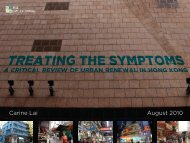Untitled - Civic Exchange
Untitled - Civic Exchange
Untitled - Civic Exchange
You also want an ePaper? Increase the reach of your titles
YUMPU automatically turns print PDFs into web optimized ePapers that Google loves.
Chapter 7:<br />
The Dynamics of Decision-making in Hong Kong<br />
The structure of the POAS reflects an attempt to facilitate "better deployment of resources and closer<br />
coordination of portfolios" rather than achieve more sustainable development for Hong Kong. Indeed, the<br />
best evidence of current government priorities is the fact that in the most senior ranks of the government,<br />
the driving goal is bureaucratic expediency rather than an understanding of policy.<br />
Case Study 1: Rail versus Road Financing<br />
The issue of rail versus road financing is covered in detail in Chapter 3. Rethinking the way in which<br />
government provides support to different transport modes, whether directly or indirectly, is critical in<br />
moving towards a more sustainable transport system for Hong Kong.<br />
Hong Kong's railways operate on prudent financial principles and are largely self-financing. The railfinancing<br />
mechanism is seen as a triumph by policy-makers, who have therefore shown little inclination to<br />
examine whether Hong Kong could be better served by an alternative policy. For example, they have not<br />
adequately considered the fact that although Hong Kong has the highest population density in the world<br />
and relies on public transport for 90% of all journeys, its rail system is skeletal in comparison with the<br />
systems in cities such as London, Paris, New York, and Tokyo (see the rail maps in Chapter 3). In other<br />
words, it is arguable that Hong Kong residents have inferior rail service compared to their counterparts in<br />
cities with similarly developed economies.<br />
Moreover, since 1999, the stated transport policy has been "to rely on railways as the backbone of Hong<br />
Kong's transport system" and to give "priority [to rail development] in government's plan for infrastructure<br />
development." 260 The question that the TB has so far been unwilling to consider is whether substantially<br />
expanding the railway network is possible if new railway projects must continue to provide a commercial<br />
return. 261<br />
The TB would argue that it has already committed to several heavy rail expansion plans that will cost<br />
billions of dollars to implement (see Table 7.1 below). 262 The issue is not that government has no plans to<br />
expand rail service but whether changing the financing mechanism would allow dramatic increases in rail<br />
service provision to major residential areas - areas that would already be served by rail in other wealthy<br />
cities. Hong Kong's rail financing policy is actually holding back the extension of medium and light rail to<br />
areas with relatively high densities. The failure to go ahead with plans for a South Island Line (SIL) despite<br />
the existence of large population centers on Hong Kong Island South is a good example of this fact.<br />
260<br />
The rail-led transport strategy was articulated in Transport Bureau (1999), Hong Kong Moving Ahead and<br />
Transport Bureau (2000), Second Railway Development Strategy, Hong Kong: HKSAR Government.<br />
261 The first page of RDS2 states that the "government acknowledges that any new railway project will have to<br />
provide a commercial return." Transport Department (2000), p.1.<br />
262 RDS2 outlined six new rail projects: the Shatin to Central Link, the Island Line Extension, the Kowloon<br />
Southern Link, the Northern Link, the Regional Express Line, and the Port Rail Line. However, the report also<br />
highlights various rail lines that would be desirable but have not been given high priority, such as a South Island<br />
Line (SIL).<br />
81

















